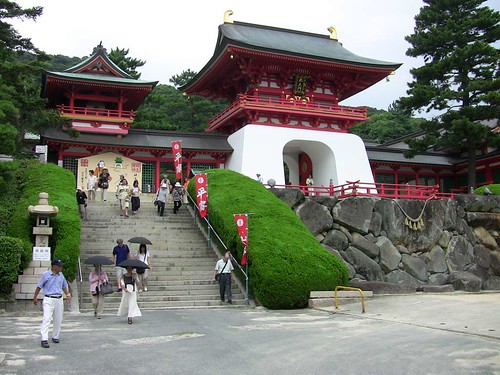Akama Jingu in Shimonoseki
Akama Jingu is one of the most interesting shrines in Japan. Here I have to explain that word shrine or jingu in Japanese means worship place for Shinto religion, which is Japan’s traditional religion, and temple – worship place for Buddhist religion, which is more modern and introduced to Japan from abroad.
Akama Jingu is located close to Kanmon straits in Shimonoseki and it is even possible to observe ships going and coming from shrine grounds. 
Image: Akamu Jingu, front gate
It was very hot day and I was hanging in the shadows of shrine for a while, enjoying silence of peaceful break between masses brought by tour buses. I started talking with shrine maidens in neat white and red dresses and received small pamphlet in English, which explains history of Akama jingu. Below I will give small summary of it for your information.
Once upon time or more precisely - 800 years ago, during battle of Dannoura between fighting clans of Heike and Genji, eight years old Emperor Antoku together with his men from Heike clan plunged into the sea and drowned in the narrowest place of Kanmon straights. During hollowing years, spirits of Heike clan warriors would haunt people around Shimonoseki – ghosts wondered around ships passing straights at night, swimmers were pulled under water and drowned. To appease those dead souls of warriors and young Emperor, Buddhist temple - Amidaji was built in present location, called – Akamagaseki.
After many years, temple was changed into a shrine. In 1940, shrine was renamed to Akama Jingu and was given first-class status shrine by government. Soon after that, shrine was burnt down during air raids. After the war, shrine was restored and finally completed in 1965.
Now after you have read the story, watch the video.
Video: Look around Akama Jingu
Google map showing location of Akama Jingu 赤間神宮:
View Larger Map
Click on map to see other places in Kyushu:



No comments:
Post a Comment